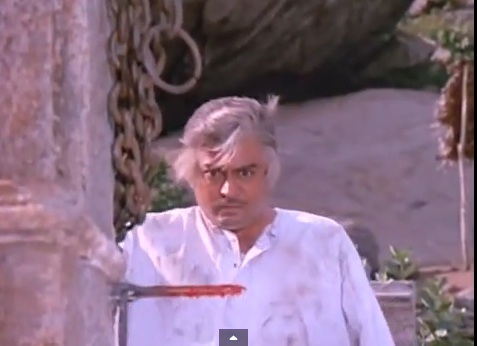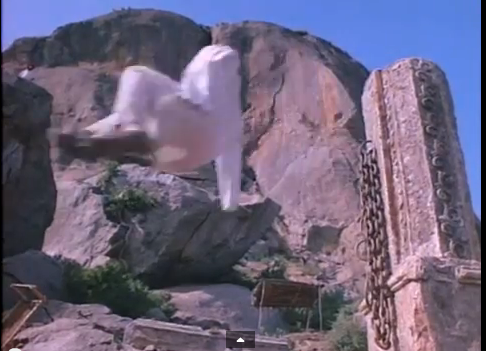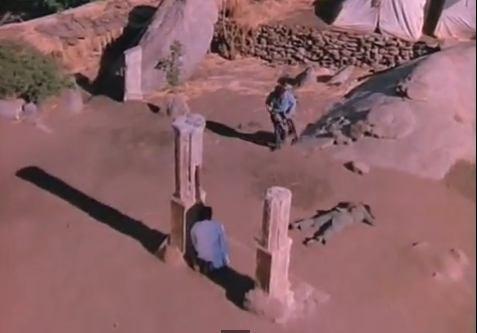Sholay
(Created page with "S S S [[File:sholaya.png|Thakur hits Gabbar with his spiked shoes. (''Sholay'' (1975): Scene delete...") |
|||
| Line 2: | Line 2: | ||
[[Category: Cinema-TV-Pop|S]] | [[Category: Cinema-TV-Pop|S]] | ||
[[Category: Cinema-Tv-Pop|S]] | [[Category: Cinema-Tv-Pop|S]] | ||
| − | + | = | |
| + | Sholay (1975)= | ||
[[File:sholaya.png|Thakur hits Gabbar with his spiked shoes. (''Sholay'' (1975): Scene deleted by the censors.)|frame|500px]] | [[File:sholaya.png|Thakur hits Gabbar with his spiked shoes. (''Sholay'' (1975): Scene deleted by the censors.)|frame|500px]] | ||
[[File:sholayaa.png|But, as Thakur discovers, it is not the spiked shoes that kill Gabbar. Thakur's assault on Gabbar's chest had made him fall on a sharp iron spike embedded in the pillar behind him. (Till the 1980s or '90s the good guys were not alllowed to kill even murderous screen villains, on the ground that death sentences were something best left to the judiciary. Therefore, during the fight sequence in the climax the haresd villain, whom the audience wanted dead,would stumble off a cliff, get bitten by a snake or die of his own bullet, so that the hero could not be accused of taking the law into his own hands.) (''Sholay'' (1975): Scene deleted by the censors.) |frame|500px]] | [[File:sholayaa.png|But, as Thakur discovers, it is not the spiked shoes that kill Gabbar. Thakur's assault on Gabbar's chest had made him fall on a sharp iron spike embedded in the pillar behind him. (Till the 1980s or '90s the good guys were not alllowed to kill even murderous screen villains, on the ground that death sentences were something best left to the judiciary. Therefore, during the fight sequence in the climax the haresd villain, whom the audience wanted dead,would stumble off a cliff, get bitten by a snake or die of his own bullet, so that the hero could not be accused of taking the law into his own hands.) (''Sholay'' (1975): Scene deleted by the censors.) |frame|500px]] | ||
[[File:sholaybb.png| The dying Gabbar falls down. (''Sholay'' (1975): Scene deleted by the censors.)|frame|500px]] | [[File:sholaybb.png| The dying Gabbar falls down. (''Sholay'' (1975): Scene deleted by the censors.)|frame|500px]] | ||
[[File:sholayc.png|Veeru (centre) brings the shawl that the armless Thakur (left) generally uses to conceal his armlessness. Gabbar lies dead on the right. (''Sholay'' (1975): Scene deleted by the censors.)|frame|500px]] | [[File:sholayc.png|Veeru (centre) brings the shawl that the armless Thakur (left) generally uses to conceal his armlessness. Gabbar lies dead on the right. (''Sholay'' (1975): Scene deleted by the censors.)|frame|500px]] | ||
| + | |||
| + | =Crew= | ||
| + | Director: | ||
| + | Ramesh Sippy | ||
| + | |||
| + | Writers: | ||
| + | Javed Akhtar, Salim Khan | ||
| + | |||
| + | Produced by | ||
| + | G.P. Sippy | ||
| + | |||
| + | |||
| + | |||
| + | Director of photography: Dwarka Divecha ... | ||
| + | |||
| + | Sound re-recording: Mangesh Desai ... | ||
| + | |||
| + | Film Editor: M.S. Shinde | ||
| + | |||
| + | Production Company: | ||
| + | United Producers, Sippy Films | ||
| + | |||
| + | =Cast= | ||
| + | |||
| + | Title: Sholay (1975) | ||
| + | Sholay (1975) on IMDb 8.6/10 | ||
| + | |||
| + | |||
| + | Dharmendra Veeru | ||
| + | |||
| + | Sanjeev Kumar Thakur Baldev Singh | ||
| + | |||
| + | Hema Malini Basanti | ||
| + | |||
| + | Amitabh Bachchan Jai | ||
| + | |||
| + | Jaya Bhaduri Radha | ||
| + | |||
| + | Amjad Khan Gabbar Singh | ||
| + | |||
| + | A.K. Hangal Imam Saheb | ||
| + | |||
| + | Satyen Kappu Ramlal | ||
| + | |||
| + | Iftekhar Narmala ji (Radha's father) | ||
| + | |||
| + | Leela Mishra Mausie | ||
| + | |||
| + | Vikas Anand Jailer | ||
| + | |||
| + | Mac Mohan Sambha | ||
| + | |||
| + | Keshto Mukherjee Hariram | ||
| + | |||
| + | Sachin Ahmed | ||
| + | |||
| + | Master Alankar Joshi Deepak | ||
| + | |||
| + | Viju Khote Kaalia | ||
| + | |||
| + | Major Anand and Bihari: The two dacoits whom Gabbar kills because they were funks (jo dar gaya) | ||
| + | |||
| + | Asrani The British-era Jailor | ||
| + | |||
| + | Gita Siddharth Deepak's mother | ||
| + | |||
| + | Helen ‘Mehbooba,’ the gypsy dancer | ||
| + | |||
| + | P. Jairaj Police chief | ||
| + | |||
| + | Jagdeep Soorma Bhopali | ||
| + | |||
| + | Jalal Agha The one who sings ‘Mahbooba’ | ||
| + | |||
| + | Om Shivpuri Inspector Saheb | ||
| + | |||
| + | Sharad Kumar: Ninni | ||
| + | =Technical Specifications= | ||
| + | Runtime: 188 min | ||
| + | |||
| + | Sound Mix: | ||
| + | 6-Track stereophonic (on 70 mm prints)| Mono (on 35 mm prints)| | ||
| + | |||
| + | Color: EastmanColor | ||
| + | |||
| + | Aspect Ratio: | ||
| + | 1.37 : 1 (original negative) / 2.20 : 1 (70 mm prints) | ||
| + | |||
| + | Country: | ||
| + | India | ||
| + | |||
| + | Language: | ||
| + | Hindi | ||
| + | |||
| + | Release Date: | ||
| + | 15 August 1975 (India) | ||
| + | |||
| + | Outdoor shooting at: | ||
| + | ‘Sippyvaram’/ Ramnagram village on the Mysore-Bangalore highway, Karnataka, India | ||
| + | =Songs= | ||
| + | All lyrics by Anand Bakshi | ||
| + | |||
| + | All music credited to Rahul Dev Burman | ||
| + | |||
| + | '' Holi Ke Din '' | ||
| + | Sung byKishore Kumar & Lata Mangeshkar | ||
| + | |||
| + | '' Jab Tak Hain Jaan '' | ||
| + | Sung byLata Mangeshkar | ||
| + | |||
| + | '' Koi Haseena '' | ||
| + | Sung byKishore Kumar | ||
| + | |||
| + | '' Mehbooba O Mehbooba '' | ||
| + | Sung byRahul Dev Burman (based on Demis Roussos’ Say you love me) | ||
| + | |||
| + | '' Sholay '' Title Theme | ||
| + | |||
| + | '' Yeh Dosti '' (happy version) sung by Kishore Kumar & Manna Dey | ||
| + | |||
| + | '' Yeh Dosti '' (Sad Version) Sung by Kishore Kumar | ||
| + | |||
| + | In addition, a qawwali had been recorded (with Anand Bakshi and Bhupendra among the singers) but not used. | ||
| + | =See also= | ||
| + | [[70mm films in India/ South Asia]] which, inter alia, pictorially demonstrates how the film was blown up from 35mm to 70mm. | ||
Revision as of 21:46, 17 March 2014
= Sholay (1975)=

Contents |
Crew
Director: Ramesh Sippy
Writers: Javed Akhtar, Salim Khan
Produced by G.P. Sippy
Director of photography: Dwarka Divecha ...
Sound re-recording: Mangesh Desai ...
Film Editor: M.S. Shinde
Production Company: United Producers, Sippy Films
Cast
Title: Sholay (1975) Sholay (1975) on IMDb 8.6/10
Dharmendra Veeru
Sanjeev Kumar Thakur Baldev Singh
Hema Malini Basanti
Amitabh Bachchan Jai
Jaya Bhaduri Radha
Amjad Khan Gabbar Singh
A.K. Hangal Imam Saheb
Satyen Kappu Ramlal
Iftekhar Narmala ji (Radha's father)
Leela Mishra Mausie
Vikas Anand Jailer
Mac Mohan Sambha
Keshto Mukherjee Hariram
Sachin Ahmed
Master Alankar Joshi Deepak
Viju Khote Kaalia
Major Anand and Bihari: The two dacoits whom Gabbar kills because they were funks (jo dar gaya)
Asrani The British-era Jailor
Gita Siddharth Deepak's mother
Helen ‘Mehbooba,’ the gypsy dancer
P. Jairaj Police chief
Jagdeep Soorma Bhopali
Jalal Agha The one who sings ‘Mahbooba’
Om Shivpuri Inspector Saheb
Sharad Kumar: Ninni
Technical Specifications
Runtime: 188 min
Sound Mix: 6-Track stereophonic (on 70 mm prints)| Mono (on 35 mm prints)|
Color: EastmanColor
Aspect Ratio: 1.37 : 1 (original negative) / 2.20 : 1 (70 mm prints)
Country: India
Language: Hindi
Release Date: 15 August 1975 (India)
Outdoor shooting at: ‘Sippyvaram’/ Ramnagram village on the Mysore-Bangalore highway, Karnataka, India
Songs
All lyrics by Anand Bakshi
All music credited to Rahul Dev Burman
Holi Ke Din Sung byKishore Kumar & Lata Mangeshkar
Jab Tak Hain Jaan Sung byLata Mangeshkar
Koi Haseena Sung byKishore Kumar
Mehbooba O Mehbooba Sung byRahul Dev Burman (based on Demis Roussos’ Say you love me)
Sholay Title Theme
Yeh Dosti (happy version) sung by Kishore Kumar & Manna Dey
Yeh Dosti (Sad Version) Sung by Kishore Kumar
In addition, a qawwali had been recorded (with Anand Bakshi and Bhupendra among the singers) but not used.
See also
70mm films in India/ South Asia which, inter alia, pictorially demonstrates how the film was blown up from 35mm to 70mm.


